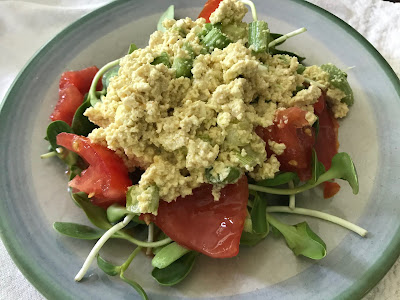"Without farmers, there is no food."
--Lailah Gifty Akita
 |
| Tofu "egg" salad with sunflower sprouts |
 |
| Garden salad with sunflower sprouts and pumpkin seeds |
Growing up healthy is not always a choice. For kids who depend on the free and reduced school meal program for 2 of their 3 daily meals, there is no choice. For kids who live in food deserts with no convenient access to grocery stores and fresh fruits and vegetables, there is no choice. For kids who are homeless and dependent on institutionalized food prepared by county jails for distribution to homeless centers, there is no choice.
We have a
long way to go to ensure that all kids have access to healthy
foods. We don’t have food equity. Here's what we do have:
Kids who are overweight or obese are more likely to grow up to be obese or overweight as adults. Kids who are victims of food inequities are more likely to be those at higher risk for chronic, preventable diseases such as diabetes.
- We have a generation of kids growing up on processed foods and sugary drinks.
- We have a generation of kids growing up obese because most of their calories come from processed and refined carbohydrates with no nutritional value and fat calories from milk, chicken, meat, and cheese subsidized by U.S. Department of Agriculture.
- We have a generation of kids exposed to unhealthy food dyes in processed foods such as breakfast cereals that contribute to lack of focus and attention deficits.
- We have a generation of kids developing type 2 diabetes because of all the empty calories in sugar-filled sodas, breakfast cereals, and cookies, saturated fats from animal products, and other junk they are being fed.
Kids who are overweight or obese are more likely to grow up to be obese or overweight as adults. Kids who are victims of food inequities are more likely to be those at higher risk for chronic, preventable diseases such as diabetes.
How do you
create food equity? Corporations make
decisions about where to place new grocery stores.
Communities can create strong business incentives and food policy decisions so that opening a store in a
highly populated food desert is a good business decision. Families can make decisions about where to
live and what food to buy. Neighborhoods can plant neighborhood gardens so the young people can help with the physical work of watering and pulling weeds and the older residents can receive some of the bounty. In exchange they can teach the kids how to prepare foods using vegetables fresh from the garden. Individuals can learn to grow food. Start with a tomato plant or peppers. Every small change helps.
The unsettling
events of 2020 have taught Americans that there is a silver lining in slowing
down the pace of our lives and starting victory gardens or learning how to make
bread. Where I live there is a lot of
shade so a traditional vegetable garden would not be successful. However, what I do
grow very successfully is sprouts.
Lentil sprouts, one of the most nutrient dense foods on the planet, take
just 3 days to grow. I use them in
salads, sandwiches, and tacos. Sunflower
sprouts are one of my favorites because they are so crunchy and delicious. Nothing bets an avocado, tomato, and sunflower
sprout sandwich on whole grain bread! And don't get me started on the nutritional value of broccoli sprouts!
To reverse
childhood obesity, we must address the systemic inequities in our food system
in this country. I can get in my car and
drive to the grocery store whenever I want. What if I didn’t have a car? There
is no public transportation close to where I live. Would I have to move to live close to a bus
line? Could I move within walking distance of a grocery store? Could I work an extra job
and save money to buy a car and insurance?
Where are the local farmers markets located? Can you get to them on a bus line or do you
need a car? In Vero Beach, Florida, home
of Growing Healthy Kids, the farmers market is located on the barrier island
which is white and affluent. I drive to
the Saturday market because I like to buy from local farmers. When we take kids to the farmers market for
our workshops, most of them are going for the first time because it is miles
away from where they live.
Every day we
make decisions that affect what we eat.
Reversing childhood obesity is not easy.
We can eat to feed disease or to be healthy. Access to real food is the barrier for many
families, whether it is lack of dependable transportation, living in a food
desert or food apartheid, or working a minimum wage job and trying to live on less than a living wage.
We must do
better. Together, we can improve the
health – and lives – of America’s children.
With love,
Nancy
Heinrich, MPH
Founder and
Wellness Architect
Growing
Healthy Kids, Inc.

